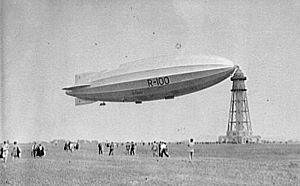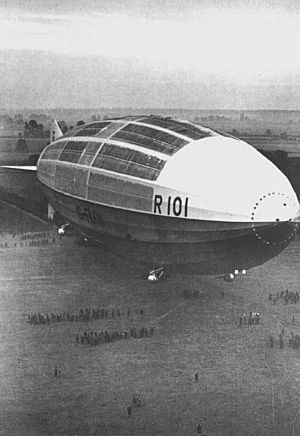Imperial Airship Scheme facts for kids
The Imperial Airship Scheme was a big project in the 1920s. Its goal was to make it easier to communicate between Britain and its far-off colonies in the British Empire. They planned to do this by creating air routes using giant airships. The first part of this plan was to build two large and very advanced airships: the R100 and the R101. In 1930, the R100 successfully flew across the Atlantic Ocean to Canada in 78 hours. However, the whole project ended in 1931 after the R101 crashed in France in October 1930. This happened while it was trying to make its first flight to India.
Contents
Why Airships? Early Ideas
In 1921, A. H. Ashbolt, who represented Tasmania, suggested creating an Imperial Airship Company. He brought this idea to a big meeting in London called the Imperial Conference. At that time, people thought it was too hard for airplanes to fly such long distances. So, airships seemed like a good solution.
The plan was for countries in the Empire to help pay for this company. Some money would also come from private groups, and the rest from the British government. A special group was set up to look into the idea. They liked it, but they felt they needed to talk more with the different governments of the Empire. In the end, only Australia felt it could afford to invest money.
In 1922, a company called Vickers Limited proposed their own plan. Vickers had been building British airships since 1911. Their idea, called the "Burney scheme," was to build six large airships for passengers. These airships would connect the countries of the British Empire. The plan was very expensive, costing about £4 million.
Building the Airships: R100 and R101
After some changes in government, a new plan was put forward in 1924. This was the official Imperial Airship Scheme. Instead of the Burney plan, they decided to build two airships. One, the R100, would be built by a special company set up by Vickers. The other, the R101, would be designed by the government's own Royal Airship Works at Cardington, Bedfordshire.
The R100 was meant to use technology that was already well-known. But the R101 was designed to try out new and creative ideas for airship building. People soon started calling the R100 the "Capitalist" ship and the R101 the "Socialist" ship. The idea was to learn from both airships and then build even better ones.
Both airships had to meet the same requirements. They needed space for 100 passengers and enough fuel to fly for 57 hours at a speed of 63 mph (101 km/h). To be accepted, they had to complete a test flight program. This program would end with a flight to India, stopping in Egypt to refuel.
Designing the Giant Ships
Barnes Wallis designed the R100. Nevil Shute Norway was in charge of all the important calculations for its strength. Nevil Shute later became a famous writer and wrote about his time working on the airships. The R101 was designed by Lt.Col. V. C. Richmond.
There was a problem with fuel. Regular petrol was not safe for airships flying in hot places because it could catch fire easily. So, the R101 was powered by diesel engines. The R100 was supposed to use engines that burned a mix of hydrogen and kerosene.
However, developing the diesel engines for the R101 was difficult. The engines ended up being too heavy and didn't produce enough power. The hydrogen/kerosene engines also had problems. So, the R100 team decided to use existing petrol-powered airplane engines instead. Because of this, the R100's test flight destination was changed from India to Canada.
Weight Problems and Delays
The R101 was supposed to be finished by July 1926, with a test flight to India in January 1927. But building the R101 took a lot longer because they had to do a lot of research first. For example, they built and tested a whole section of the airship's design. The R100 was also delayed because it was built under a fixed-price contract, and the costs quickly went over budget. Neither airship flew until late 1929.
Both airships ended up being too heavy. The R101 was heavier than the R100, mostly because of its diesel engines. The R101 also had less space for gas inside, which made its weight problem worse. To fix this, they increased the gas capacity. Later, they even added an extra section to the R101 to make it longer and lift more weight.
| R101 | R101 after extension | R100 | |
|---|---|---|---|
| Total fixed weight | 113.60 LT | 117.90 LT | 105.52 LT |
| Engines weight | 12.63 LT | 12.26 LT | 6.22 LT |
| Service load including ballast |
18 LT | 18 LT | 18 LT |
| Gasbag capacity | 4,893,740 cu ft (138,570 m³) | 5,509,753 cu ft (156,018 m³) | 5,156,000 cu ft (146,000 m³) |
| Total lift: gasbags at 96% capacity, pressure height of 1,200 ft (370 m) |
142.62 LT | 160.57 LT | 150.26 LT |
| Payload (fuel, passengers, cargo) |
11.02 LT | 24.67 LT | 26.74 LT |
The Final Flights
In August 1930, the R100 successfully flew across the Atlantic to North America. It visited Quebec, Montreal, and Toronto. Meanwhile, work started on making the R101 longer. It didn't fly again until early October. During that flight, one of its engines failed, so they couldn't do a full-speed test.
On October 4, 1930, the R101 set off for its important flight to India. The weather was bad, and it had only just received its flight permit. After about seven hours in the air, it crashed and caught fire near Beauvais in northern France. Out of 54 people on board, 48 died, including Lord Thomson and V. C. Richmond. The exact reason for the crash is still debated. Many factors likely played a role, including the pressure to complete the flight before a big meeting about the airship program.
The End of the Airship Dream
Even before the R100 and R101 flew, people realized they were too small to carry much cargo or many passengers over long distances. Designers found that a much bigger airship would be needed.
In August 1930, they decided to build two new, larger airships, the R102 and R103. These would be able to carry 50 passengers and ten tons of cargo for 4,000 miles (6,400 km). They even planned to start regular services to Karachi (in present-day Pakistan) and Montreal using the R100 and the lengthened R101. Later, the R102 and R103 would join these routes. They even thought about an even bigger airship, the R104, for a service to Australia.
But on August 31, 1931, the government decided to stop all British airship development. The R100 was taken apart. Plans for the R102, R103, and R104 were canceled. The crash of the R101, a worldwide economic downturn called the Great Depression, and doubts about how much money the airships would really make, all led to this decision.
Instead of airships, other companies like Imperial Airways started creating air routes to the Empire. They used flying boats (airplanes that land on water) and later regular airplanes.
Project Costs
The Imperial Airship Scheme was a very expensive project. Here's a look at some of the costs:
| Experimental flights of R.33 and R.34 | £103,100 |
| Cardington airship sheds | £205,800 |
| Facilities at Karachi | £120,000 |
| Mooring masts | £160,000 |
| Research | £305,200 |
| R100 | £471,113 |
| R101 | £711,595 |
| Operational costs | £30,056 |
| Overheads, administration, etc. | £290,084 |
| Total | £2,396,948 |
|---|



